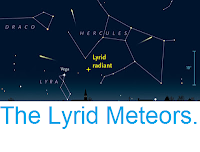The
Perseid Meteor shower lasts from late July to early September each
year, and are expected to be at a peak on Friday 11-Saturday 12 August
2017. The Moon is expected to be quite bright on that night, with the full Moon having fallen on Monday 7 August, and will be rising slightly before 11.00 pm local time on 11 August (this will b
the same wherever you are on Earth), which could
hamper viewing from most parts of the globe. The shower is expected to be
particularly intense this year, possibly reaching 80-150 meteors per
hour. The
Perseids get their name from the constellation of Perseus, in which the
meteors have their radiant (the point from which they appear to
originate).
The radiant of the Perseid Meteors. Time and Date.
The shower is caused by the Earth passing through the trail of the Comet
109P/Swift-Tuttle, and encountering dust from the tail of this comet.
The dust particles strike the atmosphere at speeds of over 200 000 km
per hour, burning up in the upper atmosphere and producing a light show
in the process.
Comet 109P/Swift Tuttle imaged during its last close approach to the Earth in 1992. Gerald Rhemann/Discover Magazine.
The Earth does not need to pass close to 109P/Swift-Tuttle for the
meteor shower to occur, it simply passes through a trail of dust from
the comet's tail that is following the same orbital path. Comet
109P/Swift-Tuttle itself only visits the Inner Solar System once every
133 years, last doing so in 1992, on an eccentric orbit tilted at
113° to the plane of the Solar System (or 67° with a retrograde orbit -
an orbit in the opposite direction to the planets - depending on how you
look at it), that takes it from 0.95 AU from the Sun (95% of the
distance at which the Earth orbits the Sun) to 51.22 AU from the Sun
(51.22 times as far from the Sun as the Earth, more than three times as
far from the Sun as Neptune and slightly outside the Kuiper Belt, but
only scraping the innermost zone of the Oort Cloud). The comet is next expected to visit the Inner Solar System in
2126, reaching about 22 950 00 km (0.15 AU) from Earth in August of
that year.
See also...
Follow Sciency Thoughts on Facebook.








